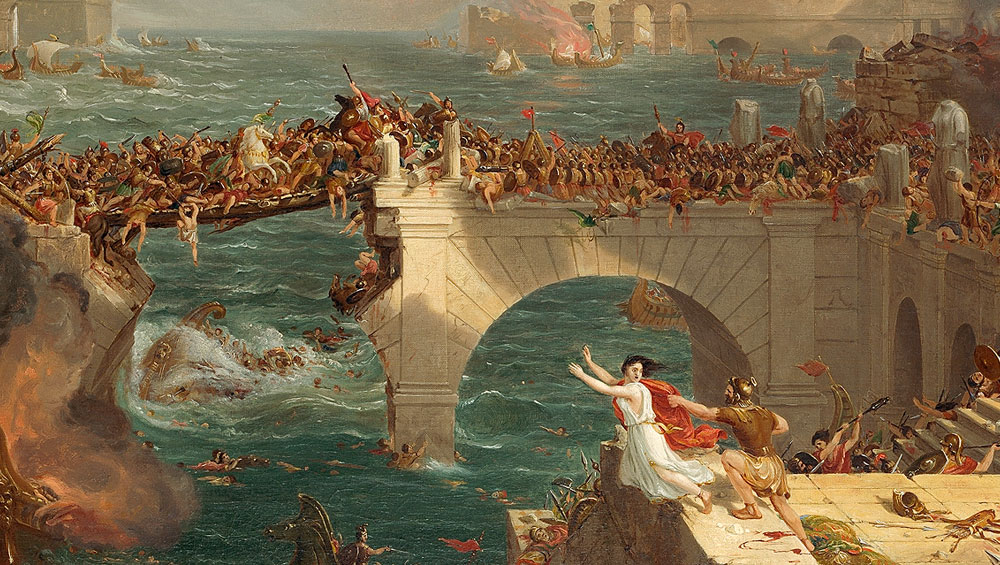
Thomas Cole. The Course of Empire: Destruction, 1836 (detail). Courtesy of the New-York Historical Society. © Collection of The New-York Historical Society, New York / Digital image created by Oppenheimer Editions.
National Gallery, London
11 June – 7 October 2018
by EMILY SPICER
They say you should never meet your heroes, and when Thomas Cole came to London and met JMW Turner, he may have agreed with that particular sentiment. He was, not to put too fine a point on it, disappointed by the British master, whose studio he found too chaotic and whose appearance he found too dishevelled, describing him as looking and acting like the “mate of a coasting vessel”. But all was not lost. He also met Constable on his visit and the two men struck up a friendship, Cole preferring, no doubt, Constable’s meticulous approach, to Turner’s experimental one.
Cole was born in Bolton, England, in 1801. He was well educated, but his father’s failing business meant that the aspiring artist’s talents were employed engraving printing blocks in a cotton mill in Chorley. Cole witnessed the burning of the local mills by the Luddites, and these scenes are thought to have influenced Destruction (1836), the penultimate painting of his The Course of Empire series, which charts the rise and fall of civilisation over five canvases – a cautionary tale of the dangers of imperial greed and corruption. These paintings were made in the US, the country that Cole and his family would make their home in pursuit of a better life.
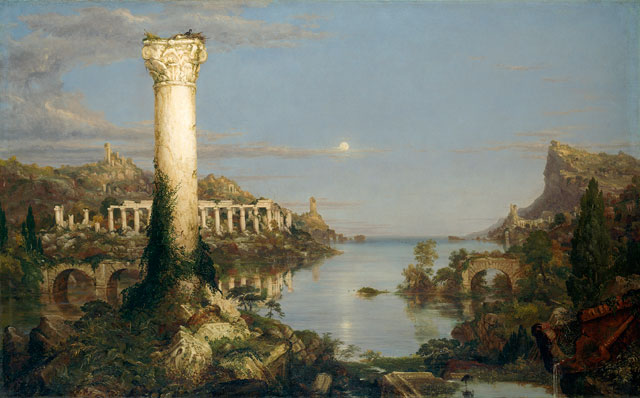
Thomas Cole. The Course of Empire: Desolation, 1836. Oil on canvas, 99.7 × 160.7 cm. Courtesy of the New-York Historical Society. © Collection of The New-York Historical Society, New York / Digital image created by Oppenheimer Editions.
Chasing the American dream paid off for Cole, who became a trailblazer of landscape painting, founding the Hudson River School and inspiring Frederic Edwin Church and Asher Brown Durand, among others, to follow in his footsteps. He was, reportedly, an excellent teacher who inspired affection in his students, but the founding principals of his practice were lost on many of his pupils, who became caught up in the excitement of an expanding, industrialising nation. This exhibition tries to dust down Cole’s image, transforming him from just another a landscape painter who fed the colonial imagination by representing empty lands ripe for the plucking, to that of a sort of proto-environmentalist, someone who cared deeply about the natural world and preserving its integrity.
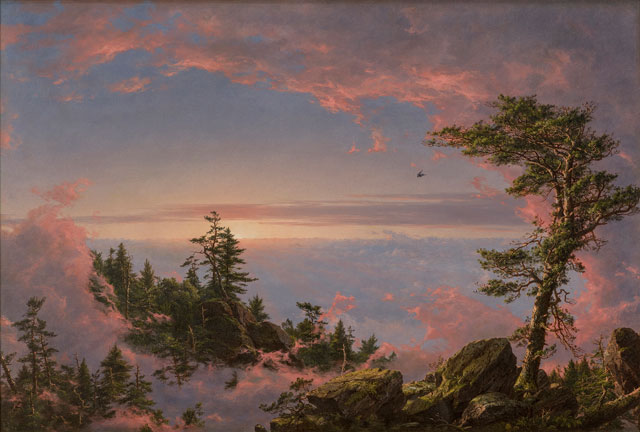
Frederic Edwin Church. Above the Clouds at Sunrise, 1849. Oil on canvas, 69.2 x 102.2 cm. Private collection.
But is this just another example of historians imprinting current concerns on the past? Not according to curator Christopher Riopelle, who suggests that Cole’s opposition to rapid industrialisation, was, in fact, an example of history repeating. While not an out-and-out Luddite, Cole was critical of urbanisation, especially of the goings-on he witnessed in New York, and disapproved of President Andrew Jackson, a mercurial populist, slave-owner and the signee of an act forcing native populations in the south from their land. President Trump is a fan and has hung Jackson’s portrait in the Oval Office. The two men, it seems, had similar governing styles.
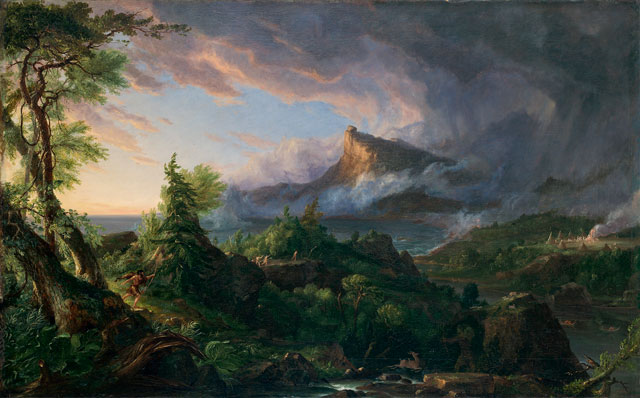
Thomas Cole. The Course of Empire: The Savage State, c1834. Oil on canvas, 99.7 × 160.6 cm. Courtesy of the New-York Historical Society. © Collection of The New-York Historical Society, New York / Digital image created by Oppenheimer Editions.
Under Jackson, aggressive economic and territorial expansion threatened the unspoilt wilderness that Cole held dear. He painted Catskill Creek as a lush, Arcadian idyll in 1837 and then returned to make a second picture in 1843 after the addition of a railroad (the company that built it went bust four years later.) The majestic trees that shade a mother and her child in the first canvas are now replaced with stumps and shredded trunks. Woodland has been cleared for fields, and, in the distance a small locomotive puffs its way across an ugly bridge.
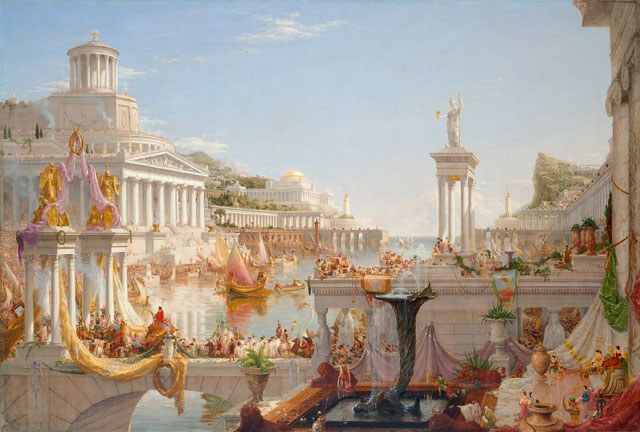
Thomas Cole. The Course of Empire: The Consummation of Empire, 1835–6. Oil on canvas, 130.2 × 193 cm. Courtesy of the New-York Historical Society. © Collection of The New-York Historical Society, New York / Digital image created by Oppenheimer Editions.
That President Jackson’s actions saw him compared to Napoleon and Caesar did not escape Cole. It has been suggested that the central painting of his The Course of Empire series is a direct comment on the president’s ambitions. The Consummation of Empire (1835–6) is an extravaganza, a tour-de-force of opulence and riches. The emperor returns to his city on the back of a gold elephant-drawn carriage dripping with ostentation. He has been to Africa and is returning with the spoils of conquest as the crowds cheer from the roofs of gleaming marble temples, or the tops of gargantuan colonnades. This is an imagining of Rome at its height, but we all know what happened to Rome.
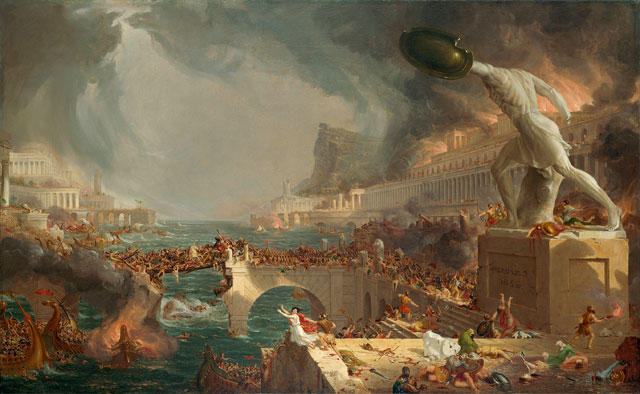
Thomas Cole. The Course of Empire: Destruction, 1836. Oil on canvas, 99.7 × 161.3 cm. Courtesy of the New-York Historical Society. © Collection of The New-York Historical Society, New York / Digital image created by Oppenheimer Editions.
In the next painting, entitled Destruction (1836), this glittering civilisation has reached its inevitable tipping point. Greed and corruption have taken hold and chaos reigns absolute. Soldiers turn on the population, slaying them brutally; a woman flees her would-be assailant by jumping into the sea, while boats burn and fires rip through the temples, and dark clouds and smoke mix above the clamour in a dramatic Turner-esque swirl. But Nature, Cole tells us, will have the last word. In the final painting, Desolation (1836), we find the same landscape stripped of its finery. Ivy subsumes the broken columns and the marble gods have toppled into the sea. It is night, now – the dusk before the new dawn, when the whole cycle will start again. If you look very closely, the moon is giving us a knowing wink. She has seen it all before and will witness it all over again.
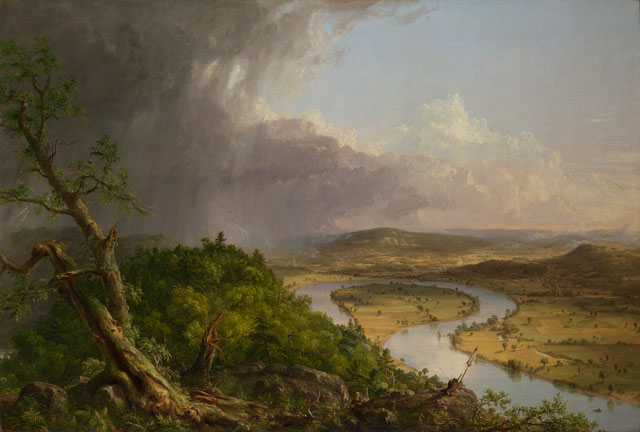
Thomas Cole. View from Mount Holyoke, Northampton, Massachusetts, after a Thunderstorm - The Oxbow, 1836. Oil on canvas, 130.8 × 193 cm. The Metropolitan Museum of Art, New York, Gift of Mrs. Russell Sage, 1908. © The Metropolitan Museum of Art. Photograph: Juan Trujillo.
But Cole’s epic, rhetorical series has a gentler counterpart. In his snappily titled View from Mount Holyoke, Northampton, Massachusetts, after a Thunderstorm – The Oxbow (1836), Cole paints both farmland and wilderness in a single composition, two opposing halves of the same landscape. Storm clouds break over the forested hills, with a now familiar sweeping drama, and a splintered tree in the foreground hints at destruction. This is the view of two possible paths and it poses a question. In fact, the serpentine curve of the river forms the very shape of a question mark. What, Cole wonders, will become of the wilderness?
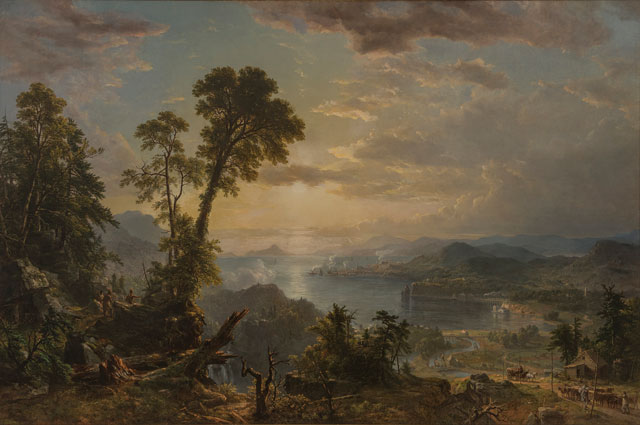
Asher Brown Durand. Progress (The Advance of Civilization), 1853. Oil on canvas, 121.9 × 182.7 cm. Private collection.
Where Church followed in Cole’s footsteps and went on to search out increasingly remote corners of the Americas, other pupils took a more positive view of urbanisation. Durand was commissioned by a New York financier to paint a large canvas celebrating industrialisation. Progress (The Advance of Civilisation) (1853) looks down on the growing township below, while three Native Americans bear witness to the spectacle from a safe distance, watching the domestic animals, boats and locomotives cut their way through the landscape. This painting, at the end of this exhibition, is Durand’s answer to the question posed by Cole’s Oxbow. The march of change is unstoppable. Our course is set.